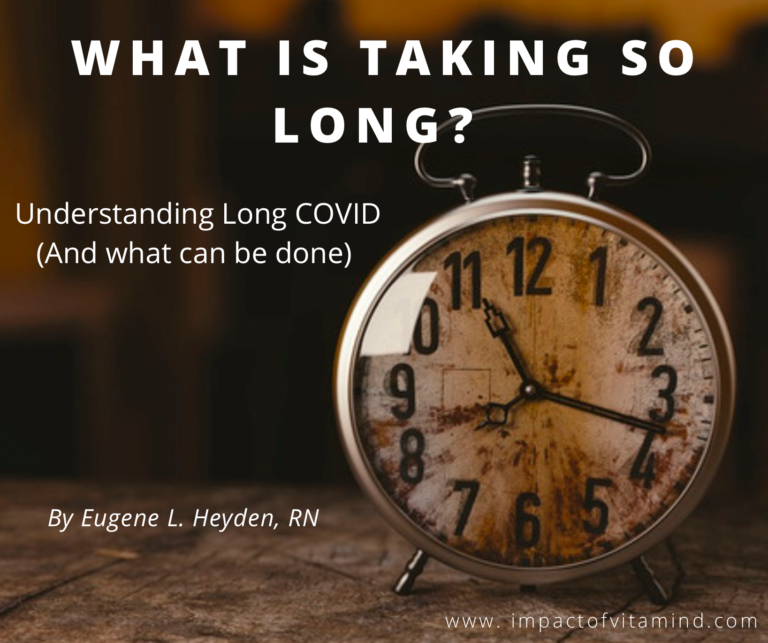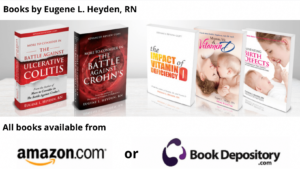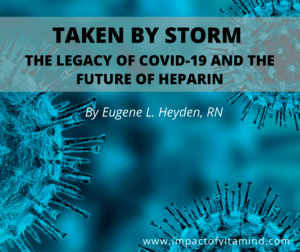What is Taking so Long? Understanding Long COVID (And what can be done)

Topic: Long COVID; COVID-19
Download a PDF of the complete article
By Eugene L. Heyden, RN
“Studies have shown that long covid can affect the whole spectrum of people with covid-19, from those with very mild acute disease to the most severe forms.
“The symptoms of long covid include fatigue, dyspnea, cardiac abnormalities, cognitive impairment, sleep disturbances, symptoms of posttraumatic stress disorder, muscle pain, concentration problems, and headache.” ~Crook et al., 2021
You can’t help but be disappointed. You recovered from COVID-19 (or so they say), but the battle is far from over. For weeks to months, you are still having symptoms, symptoms you can feel but cannot explain. Looks like you are in it for the long haul. You, like so many others, have a continuation of the original disease (COVID-19), in a form know as Long COVID. Quite surprisingly, when it comes to its development, the degree of severity of the initial infection does not seem to matter in the least. Long COVID can arise from even the mildest of COVID-19 cases.
“Many patients with mild acute symptoms also develop long covid symptoms, in fact, studies show minimal differences between the prevalence of long covid symptoms between hospitalized and nonhospitalized covid-19 patients.” (Crook et al., 2021)
Here, in this article, we will explore what is really going on here and what can be done. But first, let’s examine COVID-19 with the goal of seeing how you got from the acute infection stage to where you are today.
Understanding COVID-19
“Severe SARS-CoV-2 infection mostly presents with coagulation abnormalities, pulmonary microvascular thrombosis, and severe inflammatory response.” ~Fard et al., 2021)
You know the story. COVID-19 is caused by the virus called SARS-CoV-2. An infection follows a successful interaction between the virus spike protein and a cell surface receptor known as ACE2, found abundantly (and invitingly) throughout the human respiratory tract and mucus membranes. Following spike protein/receptor interaction, the virus enters a target cell where it can replicate and create a host of clones with the freedom to leave to infect other cells or leave to infect another individual. It needs a host in order to replicate. Someone warm like you.
The virus in question is new to the human experience. So, we were caught off guard. But it is not as though we are defenseless. We have an array of innate immune responses engineered for times like these. We normally have antivirals such as lactoferrin, pre-positioned within the mucus that lines the target cells of the respiratory tract (Zanin et al., 2016; Pisani et al., 2020). And we normally have immune cells that enter the spaces between cells for the purpose of devouring and destroying viruses and other pathogens that have been placed under surveillance and pose an imminent threat (Budinger et al., 2021). These are but two of the many defenses we have at our disposal. But this new virus is crafty and can take advantage of defects and weaknesses present in our defenses, those that allow an infection to take hold. Besides, it is also very sneaky. The SARS-CoV-2 spike protein is all dressed up in camouflage to avoid detection (Grobbelaar et al., 2021). And this seems to work all too well. Likely, the virus only wants to infect and replicate, not destroy. But destroy it has. Millions of lives have already been lost. More to follow.
Speaking of defenses, one of our more interesting and surprising defenses is known as immunothrombosis (Bonaventura et al., 2021). Likely you have never heard of it before, so I will let you in on this little secret. Simply put, when other defenses fail, allowing the virus to reach the capillary bed, the body strategically turns to clot formation, AKA thrombosis, to immobilize (freeze in place) the virus to prevent its advance into the circulation. Although this defense is quite effective, there is a price to be paid. Clotting within the capillary bed—a natural defense mechanism directed against viruses and bacteria that dare to enter the bloodstream—has the power to interfere with oxygen delivery to the very tissues it is trying to protect (Kell et al., 2022). This is the disease that the disease creates! SARS-CoV2 evokes clot formation which impairs tissue oxygenation at the capillary level. And from this, people need ventilators. And from this, people need prayers for recovery. And so begins a life-or-death struggle. This struggle invites the strong possibility that immune responses will become so intense, so frantic, that an individual can be taken from us by what is called a “cytokine storm.”
“The cause for which patients with severe COVID-19 die is not related to the damage caused by the replication of the SARS-CoV-2 virus but rather it seems to be linked to the so-called cytokine storm.” (Lete, 2021)
Above is the streamlined version of disease progression in COVID-19. Unfortunately, as COVID-19 transitions over time into a chronic form, the clotting continues. We call it Long COVID.
Long COVID is . . .
To continue reading, click here: What is taking so long
Related posts
Topic: Long COVID; COVID-19
References
Bonaventura A, Vecchié A, Dagna L, Martinod K, Dixon DL, Van Tassell BW, Dentali F, Montecucco F, Massberg S, Levi M, Abbate A. Endothelial dysfunction and immunothrombosis as key pathogenic mechanisms in COVID-19. Nature Reviews Immunology. 2021 May;21(5):319-29. https://www.nature.com/articles/s41577-021-00536-9?elqTrackId=9a206ed2d5ee4a3fa6306f5a40c06750
Budinger GS, Misharin AV, Ridge KM, Singer BD, Wunderink RG. Distinctive features of severe SARS-CoV-2 pneumonia. Journal of Clinical Investigation. 2021 Jul 15;131(14):e149412. https://www.jci.org/articles/view/149412/files/pdf
Crook H, Raza S, Nowell J, Young M, Edison P. Long covid—mechanisms, risk factors, and management. bmj. 2021 Jul 26;374. https://www.bmj.com/content/374/bmj.n1648.abstract
Fard MB, Fard SB, Ramazi S, Atashi A, Eslamifar Z. Thrombosis in COVID-19 infection: Role of platelet activation-mediated immunity. Thrombosis Journal. 2021 Dec;19(1):1-1. https://link.springer.com/article/10.1186/s12959-021-00311-9
Grobbelaar LM, Venter C, Vlok M, Ngoepe M, Laubscher GJ, Lourens PJ, Steenkamp J, Kell DB, Pretorius E. SARS-CoV-2 spike protein S1 induces fibrin (ogen) resistant to fibrinolysis: Implications for microclot formation in COVID-19. Bioscience reports. 2021 Aug 27;41(8). https://portlandpress.com/bioscirep/article-abstract/41/8/BSR20210611/229418
Kell DB, Laubscher GJ, Pretorius E. A central role for amyloid fibrin microclots in long COVID/PASC: origins and therapeutic implications. Biochemical Journal. 2022 Feb 17;479(4):537-59. https://portlandpress.com/biochemj/article-abstract/479/4/537/230829
Lete I. Combined hormonal contraception and COVID-19. The European Journal of Contraception & Reproductive Health Care. 2021 Mar 4;26(2):128-31. https://www.tandfonline.com/doi/abs/10.1080/13625187.2020.1867845
Pisani A, Rizzo M, Angelucci V, Riccio E. COVID-19 Experience in hemodialysis patients: a cue for therapeutic heparin-based strategies?. Nephron. 2020;144(8):383-5. https://www.karger.com/Article/Abstract/508638
Zanin M, Baviskar P, Webster R, Webby R. The interaction between respiratory pathogens and mucus. Cell host & microbe. 2016 Feb 10;19(2):159-68. https://www.sciencedirect.com/science/article/pii/S193131281600038X
DISCLAIMER: This article is offered solely for informational purposes. The information contained therein and opinions expressed should be evaluated for accuracy and validity in the context of opposing data, new information, and the views and recommendations of a qualified health care professional, and not to be substituted for professional judgment and guidance or to provide a reason to neglect or delay appropriate medical care for self or for others. It is the reader and reader only who bears the responsibility for any actions that could be construed as being a response to the information presented. The statements and opinions expressed by the author have not been reviewed or approved by the FDA or by any other authoritative body, nor is the author endorsing any product or specific therapy mentioned. This article and the opinions contained therein are offered to the reader to broaden his or her understanding of the issues discussed and to help identify options that may be suitable for the individual to pursue, on behalf of self or others, under approval and direction of a qualified physician or medical team member. All questions of a medical nature which arise from reading this article should be directed at qualified health care professional. There are no guarantees that a suggested website and internal links are safe to visit or open or are currently available.
Copyright © 2022 Eugene L. Heyden, RN
All Rights Reserved.


